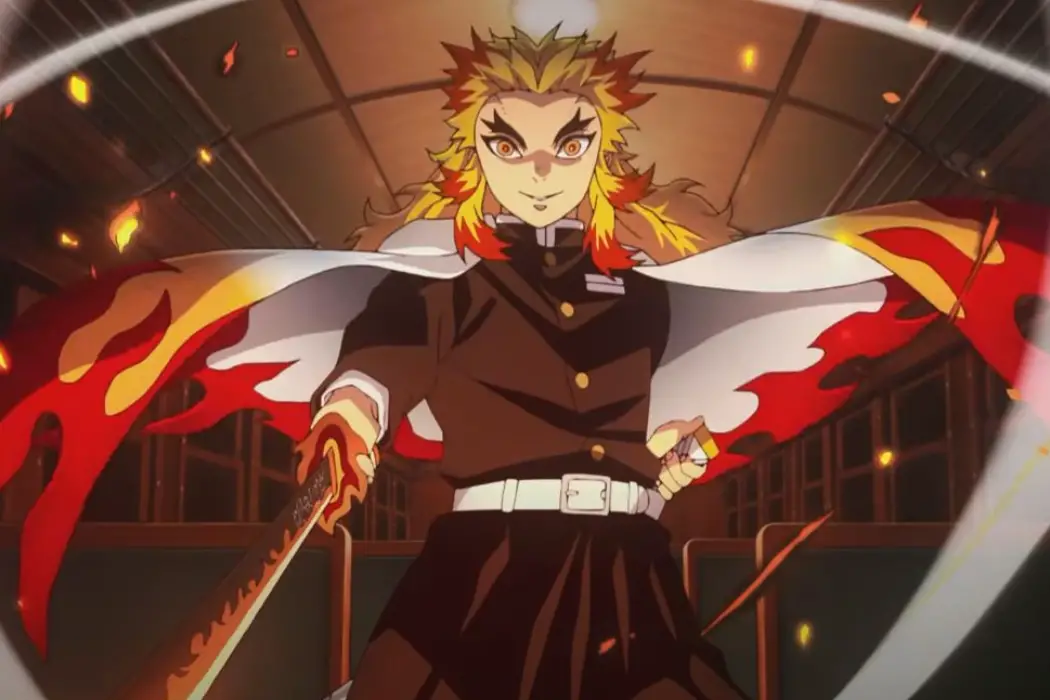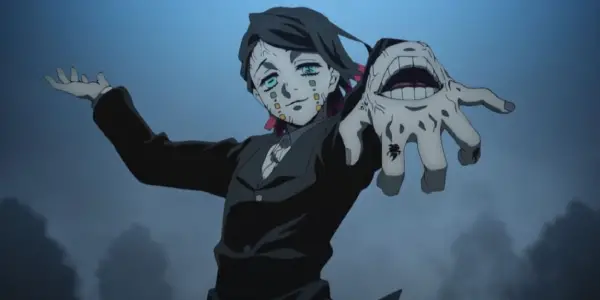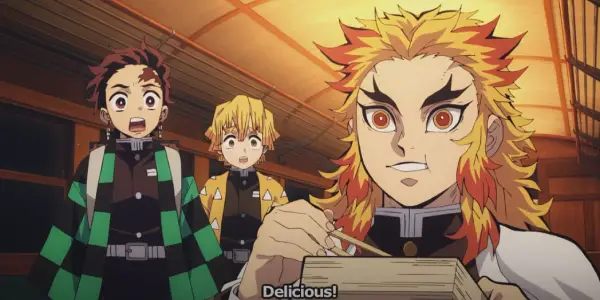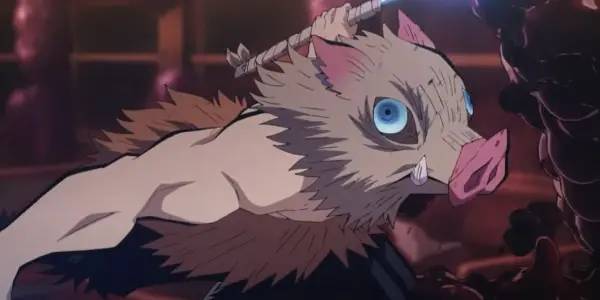DEMON SLAYER: MUGEN TRAIN: Action & Emotions Collide In Japan’s Highest-Grossing Film

Bailey Jo is a visual journalist currently living near Seattle.…
One of the more surprising things to come out of the COVID-19 pandemic is the fact that it bore the highest-grossing film of all time in Japan, Haruo Sotozaki‘s Demon Slayer: Kimetsu no Yaiba the Movie: Mugen Train, which overtook the record set by Spirited Away (Sen to Chihiro no Kamikakushi) way back in 2001.
This is a really big deal as Spirited Away is not only one of Hayao Miyazaki’s most beloved films, but also THE film that introduced a new generation of English speakers to the wonders of Japanese cinema and the magic of Studio Ghibli. So what is it about Mugen Train that allowed this movie to get as many people into theaters as possible in a time where – in many places – watching films in a theater is not an option?
Simply put, Demon Slayer is an insanely popular manga and anime in Japan where you’ll often hear the show’s theme song playing at the local department store and every other little kid you run into will have a Demon Slayer-themed mask on. When you consider the fact that the first season of the anime transitions right into the film – with Tanjiro and Co. boarding the Mugen train to investigate some disappearances – then it makes complete sense that Japanese Demon Slayer fans would show up to see the next chapter in the story.
Think of it as HBO’s Game of Thrones if the only way you could have watched the Red Wedding was in a movie theater: one of the biggest, most anticipated episodes of the entire series and it’s only available at the cinema. While Mugen Train is a highly entertaining movie with plenty of heart and action, I wouldn’t go so far as to call it a great film.
Some Background
In order to understand the story of Mugen Train, one must understand the story of the series: in Taisho-era Japan (roughly a century ago) a boy named Tanjiro (Japanese: Natsuki Hanae; English: Zach Aguilar) returns to his mountain home to find that his mother and his younger siblings have all been killed by a demon and that his younger sister Nezuko (Japanese: Akari Kito; English: Abby Trott) has transformed into a demon herself.
In this world, demons are former humans that have been transformed into immortal beings that must eat humans/drink human blood for energy. Their weaknesses are sunlight, wisteria flowers, and special swords that the Demon Slayer Corps use, but their strengths have variety – some demons are more powerful than others but none are more powerful than Muzan Kibutsuji, the original demon.
In this world, demons aren’t well-known by the general public, but the ones who are unfortunate enough to know of them understand demons to be evil and bloodthirsty. As it turns out, Nezuko is different.
Despite initially attacking her brother after being transformed, a part of Nezuko that is still human proved itself stronger than her new demonic instincts and she actually ends up protecting him from Tomioka, a Demon Slayer. Because Tomioka recognized this, he spared Nezuko’s life and directed Tanjiro down the path to become a Demon Slayer himself and find a way to turn Nezuko back into a human.
It’s For The Manga & Anime Fans
Tanjiro, Nezuko, and their two friends Zenitsu (Japanese: Hiro Shimono; English: Aleks Lea), a coward who doesn’t realize his own incredible power, and Inosuke (Japanese: Yoshitsugu Matsuoka; English: Bryce Papenbrook), a wild, self-taught Slayer who wears the head of a boar, who are investigating the disappearances of humans on a train alongside a Hashira (the highest-ranking members of the Demon Slayer Corps) named Rengoku, a peculiar and incredibly strong Slayer whom they all admire and look up to.
They must all go up against Enmu, a demon who had risen the ranks of Kibutsuji’s “Twelve Kizuki” (the most powerful demons in the world besides Kibutsuiji himself). Enmu’s “Demon Blood Art” is dream manipulation, which makes complete sense as his name means “Nightmare Dream/Vision” and his powers of dream manipulation can be compared to the abilities founds in other films like A Nightmare On Elm Street or Paprika.

Enmu (Japanese: Daisuke Hirakawa; English: Landon McDonald) loves to give his victims a beautiful dream – tapping into their subconscious and their souls – and then transforming it into a horrific nightmare right before he kills them. For some reason, Enmu needs to manipulate desperate and sick humans to actually do the dirty work of going into multiple victims’ dreams and killing them.
The movie’s narrative is set up into roughly four parts: getting to know Rengoku (Japanese: Satoshi Hino; English Mark Whitten), getting caught in Enmu’s dream manipulations, fighting Enmu, and then, just when you think it’s over, a showdown between Rengoku and another demon named Akaza. While this isn’t a terrible way to separate the acts in the movie, it makes it feel more like four separate episodes of the anime edited together, actually makes it feel like less of a film.
The action and the animation are breathtaking in Mugen Train, but then again, the animation has always been that way, even in the anime. So why was this story made into a film? The “Mugen Train” arc in the manga is certainly an important one and, when looking at the themes presented throughout those pages and how they’re interpreted onto the screen, it begins to make more sense that we would have this film. In the context of this absolutely stellar franchise, the movie makes sense but that doesn’t make it a great film. It’s for the fans and there’s honestly nothing wrong with that.
Power of Empathy, Empathy of Power
To say that Mugen Train is “for the fans” isn’t a way to dismiss it or to say that it’s not worth watching – what it means is that Demon Slayer is a manga/anime franchise that is worth investing one’s time and energy into because it is SPECIAL. In 2020, an education and publishing company in Japan did a survey of 7,661 elementary school students, with one of the questions being “who do you admire most?” At the very top of that list was Tanjiro, the main protagonist of Demon Slayer, with several other characters from the franchise making up the Top Ten (on this list, “My Mom” is #2, “My Teacher” is #4, and “My Dad” is #5).

And honestly, who can blame them? Tanjiro is an incredibly compassionate and empathetic male character that anyone could/should look up to. Everything Tanjiro does – all of the backbreaking training and highly dangerous battles – is for the benefit of helping Nezuko become a human again. Tanjiro’s deep loyalty to his sister and his impressive sense of smell (which gives him the ability to understand the emotions of others) allows him to navigate the world in a way that makes him compassionate and good.
Every time he’s defeated a demon, he smells the grief and regret they may feel in their dying moments and he, better than any other Demon Slayer, remembers that demons were once human themselves. Tanjiro’s decency towards these demons in their final moments is a truly awesome and beautiful thing to behold; it’s so easy to think in terms of black-and-white, especially in a series for children, but Demon Slayer is written in a way that makes you question that way of thinking.
Tanjiro’s decency is actually so potent that, in the movie, when one of Enmu’s minions encounters Tanjiro’s soul so that he can destroy it (and Tanjiro), the boy is overcome with how calm and beautiful the physical representation of Tanjiro’s very spirit is, inspiring him to betray Enmu.
There are quite a few emotional climaxes in the film, but none are quite as powerful as what feels like the film’s 3rd final act – when Rengoku fights Akaza. After everyone breaks free from their dream manipulations and Enmu is (finally) taken down, the train has crashed and Tanjiro is seriously injured. Rengoku guides him through his breath control training, instructing Tanjiro to use his training to stop any internal bleeding he’s sustained. At the end of the first season of the anime, Tanjiro spent many episodes training to be able to do this, and with Rengoku’s calm reassurance, he’s able to. But suddenly! An attack from the third strongest of the Twelve Kizuki demons, Akaza! Rengoku easily diverts Akaza’s attack and the insanely powerful demon loses interest in Tanjiro and sets his sights on Rengoku.
Throughout the film, we’re shown how incredibly powerful and physically strong Rengoku is and we also learn how strong his moral virtues are; as shown in Rengoku’s dreams, his father thought that rising to become a Hashira is “worthless” while his mother encouraged him to use his strength to only help others, telling him that it’s his duty to do so. As the truly epic battle ensues, Akaza at one point pleads with Rengoku to submit and become a demon, saying that his strength is wasted on his being a mortal.

This entire last section of the movie is completely engrossing and by the end, you’re fully invested in the outcome of this seemingly random battle. However, it feels like an add-on, an almost overblown emotional hurrah that wouldn’t make sense in any other movie – the “Mugen Train” story is over, so why is there still 30 minutes left in this movie?! It’s a cinematic paradox as the Rengoku VS. Akaza battle is the real climax for the story arc, yet it feels like the narrative is bogged down. For fans of the franchise, it’s necessary for the overall Demon Slayer storyline, but for a casual viewer, it’s a chore and a half to watch.
Conclusion
In the end, Mugen Train is an average movie tossed into the middle of a sensationally beautiful and thoughtful anime. Essentially a 6-episode story arc curated into one film, it’s really something only a fan of the series can truly love, but then again, everyone should be a fan of the series. If there’s anything you should take away from this, it’s that the story of Tanjiro and his sister Nezuko is one worth diving into headfirst (just like Inosuke in any and all situations).
What did you think of Mugen Train? Are you excited for season two of Demon Slayer? Let us know in the comments!
Demon Slayer: Mugen Train is in theaters now.
Watch Demon Slayer: Mugen Train
Does content like this matter to you?
Become a Member and support film journalism. Unlock access to all of Film Inquiry`s great articles. Join a community of like-minded readers who are passionate about cinema - get access to our private members Network, give back to independent filmmakers, and more.
Bailey Jo is a visual journalist currently living near Seattle. Along with obsessively watching movies, she enjoys creating art, playing guitar, and trying to get some sleep.













